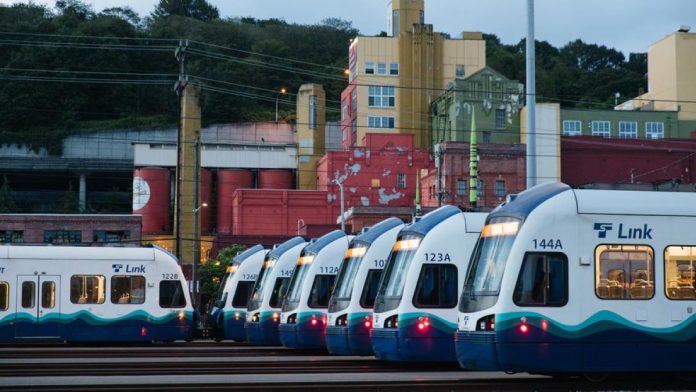
Recently, Sound Transit confirmed what many observers had dreaded hearing – cost estimates for the full build out of the Sound Transit 3 (ST3) expansion program have ballooned to the point that there is now a budget deficit of $20-30 billion. A combination of inflationary pressures and declining tax revenue projections, along with newly needed maintenance and reliability projects, means that Sound Transit must now grapple with the tough decision of how to successfully deliver the promised expansions in ST3, while still not exceeding its capital budget.
In the coming months, Sound Transit will have to make difficult decisions on project realignment and reevaluation. This will likely result in elimination of stations and infrastructure, project deferrals, and even the indefinite tabling of certain projects or project elements, too.
Recently, even before this budget deficit was made public, some observers had floated the idea of eliminating the second Downtown Seattle Transit Tunnel, or DSTT2 for short, which is a component of the proposed Ballard Link Extension (BLE). This project is perhaps the most crucial part of ST3, resulting in an expansion of Link light rail service through the densest parts of Seattle and King County.
Nevertheless, recently updated cost estimates peg the overall cost of Ballard Link at upwards of $22 billion. A large component of this cost includes the DSTT2, which is proposed to parallel the existing Downtown Seattle Transit Tunnel (DSTT) from Chinatown-International District (CID) station to Westlake, before continuing on to South Lake Union, Seattle Center, and onwards to Ballard.
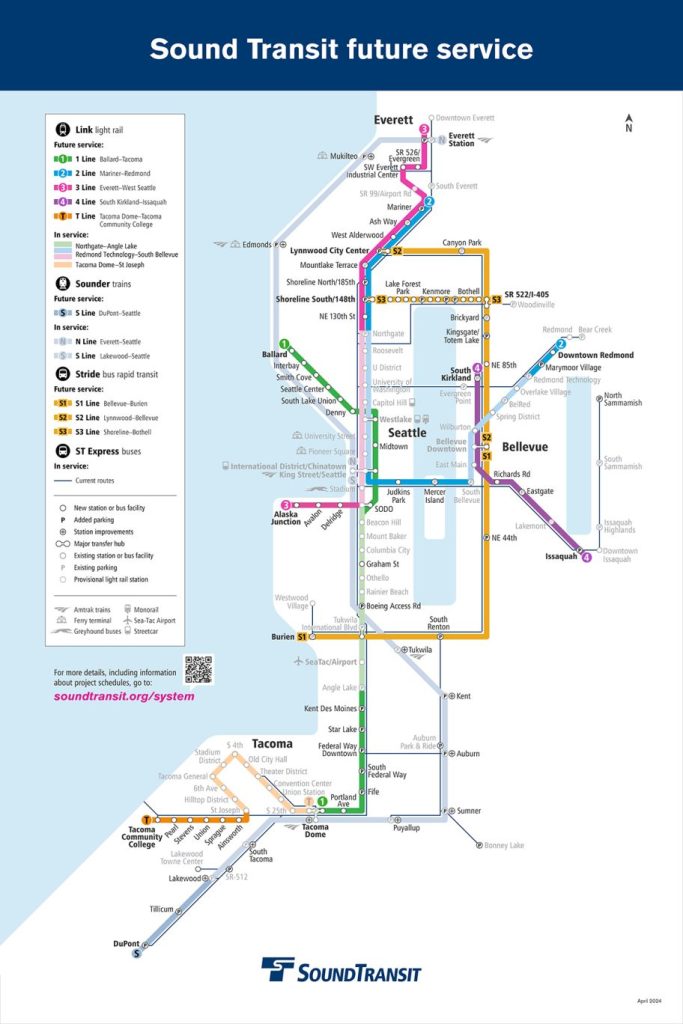
Understandably, some observers have questioned the necessity of the portion of the DSTT2 between CID and Westlake, arguing that valuable money could be saved by instead utilizing the existing DSTT, and finding a way for the portion of Ballard Link between Uptown and Westlake to interchange with existing Link service at Westlake. As noted in a recent The Urbanist article, there are two scenarios in which this could occur:
- Truncating Scenario 1 would truncate Ballard Link at Westlake station, forcing riders to transfer there to connect to other Link services, or
- Interlining Scenario 2 would connect the Ballard extension to the existing DSTT north of Westlake, interlining Link service through the DSTT.
While these scenarios sound appealing due to their perceived cost savings, there are extreme drawbacks to both of these hypothetical scenarios.
Through evaluating these hypothetical scenarios and illuminating their shortcomings, I expect Sound Transit to find the region is actually better off building Ballard Link as a whole, with a DSTT2 included, rather than attempting to cobble together a patchwork system that fails to adequately meet current and future ridership demand for the region.
Scenario 1 – Terminate Ballard Link Early at Westlake
Regardless of how Ballard Link ultimately ends up being built, Westlake will likely serve as the main hub of Link. DSTT2 or not, it will become a crucial interchange station between the Ballard extension and existing Link service, specifically towards points of the network north of Westlake, such as the University of Washington, Northgate, Lynnwood, and Everett. However, terminating Ballard Link at Westlake and failing to build a DSTT2 that continues southward to CID and beyond would be a crucial mistake for multiple reasons.
Firstly, the agency’s working Ballard Link proposal assumes that the alignment will not make any connections to existing Link tracks until SoDo, when it reaches the above-ground portion of the line. This means that from SoDo north, the entire Ballard Link alignment does not have any connecting tracks to the DSTT, or the rest of the existing Link network. Should BLE be truncated early to end at Westlake, a massive problem would arise of how Ballard Link would connect to the rest of the Link system.
Sound Transit has not included a new operations and maintenance facility (OMF) in the Ballard Link plan or budget; the agency’s plan to route Ballard Link through a new DSTT2 means it would have access to the existing Central OMF in SoDo, and future OMF South in Federal Way. Without this connection, there would be no way for trains to actually operate on the truncated Ballard Link tracks.
If Ballard Link terminates early at Westlake, Sound Transit would have to look at constructing a wholly separate OMF for just BLE, and this would have to be built above ground. The only portion of Ballard Link that is above ground north of Westlake is the section between Seattle Center and Interbay. This area is completely built up, and OMFs take up a considerable amount of land (which is why Sound Transit’s future OMF North and South are currently evaluating possible sites far away from major population centers).
The only potential location in this area that could perhaps serve as the location for a Ballard Link-only OMF would be the Interbay Golf Course. Interbay Golf Course sits atop a capped old landfill, complicating efforts to construct a base on top of it. While golf courses represent inefficient land use, acquiring this land for an OMF would be a difficult and exorbitantly expensive undertaking, and this would still not address another operational issue that would arise with truncating BLE early at Westlake.
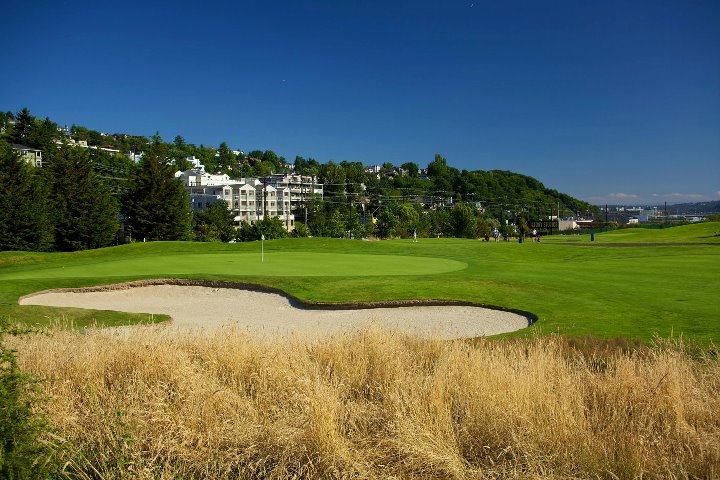
Short of building a brand new OMF somewhere in Seattle, a truncated Ballard Link would require some sort of connecting track to be built between the new line and the existing DSTT in order to provide a route to existing OMFs. This would require the construction of a new junction box along the existing DSTT north of Westlake (this is a point that will be readdressed in the evaluation of Scenario 2). Without such a connection, Ballard Link would essentially operate on its own – an island network from the rest of Link. Should operational issues occur, such as fleet issues with the trains stored at the BLE-only OMF, it would be highly difficult to move trains from the rest of the Link network to BLE, as they’d have to be schlepped in on another vehicle.
Another crucial drawback of truncating Ballard Link at Westlake is that it would place an extreme stress on Westlake as the sole transfer interchange between BLE and existing Link service. Under the current planned alignment, Sound Transit envisions three interchange points between Ballard Link and other Link service – Westlake, Pioneer Square-Midtown/CID, and SoDo. Having each of these interchange points may seem extremely redundant, but that’s the entire point. Ballard Link ridership is projected to be extremely high at between 132,000 and 172,000 daily riders, and having multiple transfer points allows Link to evenly distribute these transferring riders across multiple points on the system. Without a second tunnel, those thousands and thousands of rides would now need to cram onto DSTT trains already full of Central Link and East Link riders.
It’s extremely difficult to project how ridership would be altered by truncating Ballard Link at Westlake, but it would still no doubt face extreme crush loads and high passenger traffic as the sole interchange point. Sound Transit’s recent study on how a Pioneer Square/Midtown interchange station alignment would compare with a CID interchange station alignment on overall transfer ridership numbers and patterns between Ballard Link and existing DSTT Link service offers some insights, though.
Sound Transit projects between 183,000 and 185,000 daily riders on the Link network as a whole interacting with the DSTT and DSTT2 – just between Westlake and SoDo stations. Under this existing proposed service alignment, Westlake serves as an interchange point for Ballard Link riders headed to points north on the future 2 Line or 3 Line (e.g. anywhere between Capitol Hill and Everett). Pioneer Square Station serves as an interchange point for all riders choosing to interchange between 2 Line service east of CID and all Link service south of Downtown, and SoDo Station serves as an interchange between all riders choosing to transfer between the West Seattle Link and all Link service south of SoDo.
Truncating Ballard Link at Westlake means the station will be forced to single-handedly accommodate the load of hundreds of thousands of riders daily, possibly for the foreseeable future. This places unneeded strain on a particular point of the network, threatening the reliability of not just Ballard Link and the existing DSTT, but for Sound Transit and the region as a whole.
An important caveat is that ridership projections are extremely contingent on things like a full buildout of all ST3 projects, which is obviously something that will certainly change. The ridership projections being cited in this article will likely be somewhat lower if Sound Transit must cut stations and operational frequencies to make the ST3 expansion budget work. Nevertheless, downgrading from having multiple transfer points between Ballard Link and its roughly 130,000-170,000 projected riders to only one station is extremely degrading to the effectiveness of the system as a whole.
Scenario 2 – Truncating BLE and Connecting it to the Existing DSTT
Under this scenario, Sound Transit would interline all future Link service through the same section of the DSTT between Westlake and CID stations. The main point underpinning this plan to use the existing DSTT for all future Link services is based on the fact that Link and its trains are designed to operate at frequencies as low as 90 seconds. Assuming Sound Transit were to implement the necessary signaling upgrades in the DSTT, it is technically feasible to achieve this level of service – even if operationally challenging to maintain these tight headways on very long light rail lines, with the Rainier Valley and SoDo at-grade sections partially in mixed traffic.
However, many people advocating this alternate scenario fail to realize the main issue preventing this from actually becoming an implementable reality: the complexity of connecting the Ballard Link alignment to the existing DSTT.
Connecting a new tunnel to an existing one is no simple feat – it’s more than just drawing a new line that seamlessly connects to an existing line on a transit map. Railways require complex infrastructure, and for two different rail lines to interchange, a railway junction must be constructed. Underground railway junctions require the construction of a junction box, which is, in essence, a large underground structure that allows for the actual interchange of two railways to occur. Because a junction box requires for the structure to be dug out of the existing ground, underground railway junctions are often quite rare.
A further caveat regarding existing underground junction boxes is that they were often built in conjunction with the rest of the railway alignment – it is nearly unprecedented to build an underground junction box along the alignment of an existing underground railway line.
Building a junction box around an existing underground railway tunnel, which is what would be needed in order for Ballard Link to connect to the DSTT to achieve interlining, is nearly impossible to do without disrupting existing service. The existing DSTT was dug using a tunnel boring machine (TBM) between International District station and Westlake Station. This means that constructing a junction box along this particular alignment would be highly difficult – nearly impossible to do – because construction would require digging out the ground around the existing tunnel segments, and building a junction box around them to allow for an interchange between the rails of the existing DSTT, and the new Ballard Line tunnel. This would result in extreme operational reductions on existing Link service, possibly even a complete shutdown of Link service through the DSTT – these are likely nonstarters for Sound Transit.
Furthermore, going back to the often-repeated suggestion of operating trains in the existing DSTT with 90 second headways – such operations would necessitate the construction of a unique, more complicated flying junction. This variation of a railway junction is achieved by separating the junctions of each direction into two levels, one level for each direction of travel, so as to eliminate conflict points between opposing directions of travel. This therefore requires an underground junction box to be constructed deep enough to accommodate two levels of railway junctions above each other.
Moreover, it would also require altering the track gradients of at least one direction of travel for Link service in order to accommodate the tunnels that branch off to BLE to pass underneath the tunnels of the DSTT without issue. Trains cannot descend and ascend as quickly as cars, meaning that a lengthy section of tunnel would need to be reconstructed for the approaching tracks in each direction to descend and ascend to a lower depth.
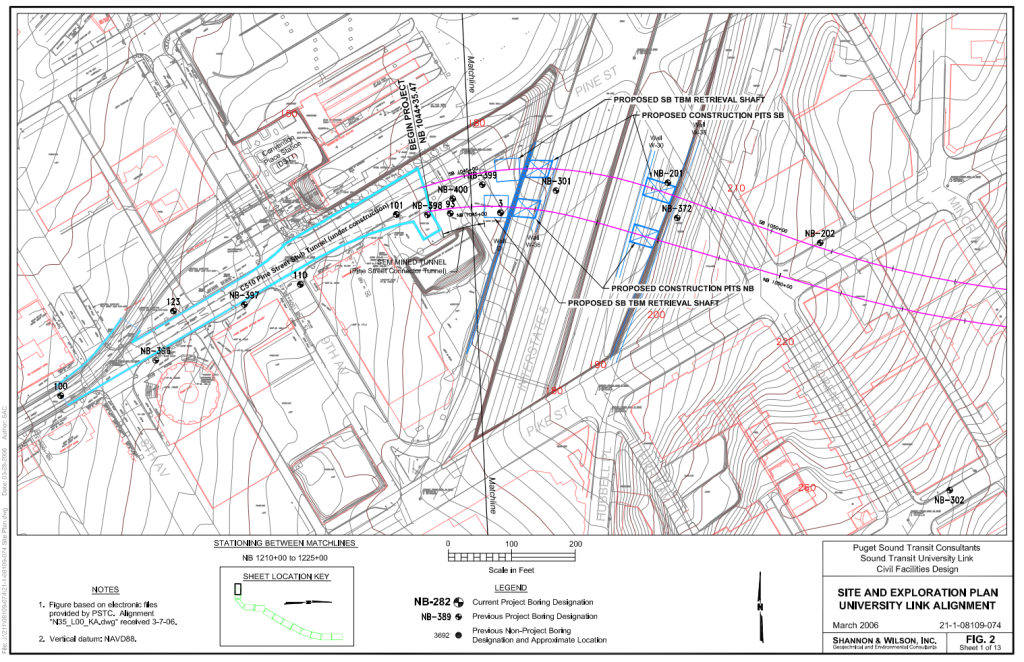
There is a limited, extremely theoretical opportunity for such a flying junction to be constructed north of Westlake station along the section of tunnel extending past Westlake Station along Pine Street. Between the eastern end of the Westlake station box along 6th Avenue and the beginning of the TBM-dug University Link tunnels at 9th Ave, this section of tunnel was dug using cut-and-cover methods, meaning the tunnel is relatively close to the surface. Additionally, a bellmouth (a space protruding out of the main tunnel structure) exists as a relic of the now-demolished Convention Place station, which could be hypothetically used to accommodate one of the levels of the underground flying junction. A hypothetical service scenario where a (non-flying) rail junction is constructed using this existing bellmouth structure is illustrated below.
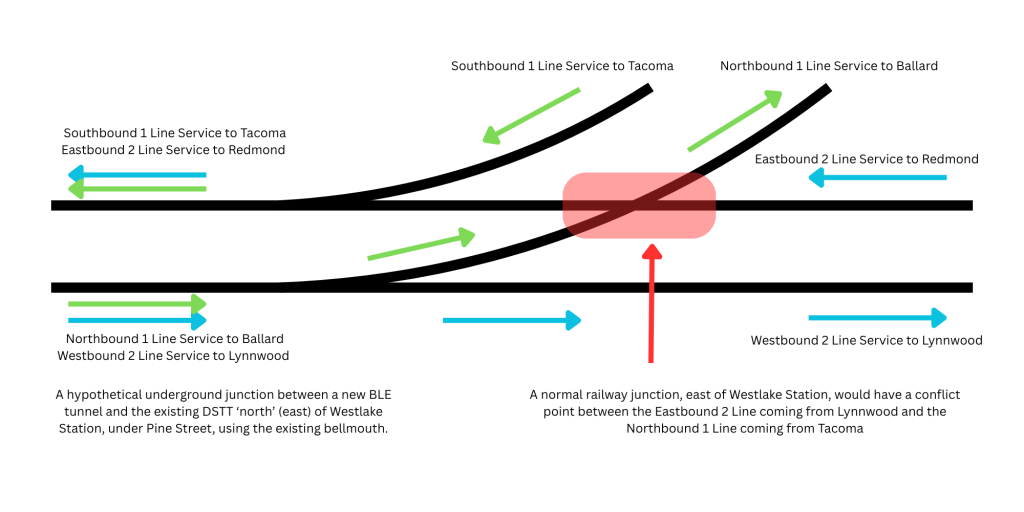
As illustrated above, a regular, non-flying junction here would likely be feasible to build. Furthermore, the property at the intersection of Pine Street and 8th Avenue currently contains a parking lot, allowing for a possible southern TBM retrieval site at the end of a proposed truncated BLE tunnel.
However, as previously stated, this junction would impose severe operational limitations on future Link service due to the above highlighted conflict point between trains heading in opposing directions between Ballard Link (the 1 Line) and the 2 Line entering the DSTT. Furthermore, non-flying junctions lead to operational limitations and associated challenges – 90 second headways in the DSTT would be impossible to achieve with this sort of BLE-DSTT connection. The Red-Purple Bypass Project, which was completed in 2021 in Chicago, illustrates how operational challenges can be caused by railway junctions that are not properly built as flying junctions.
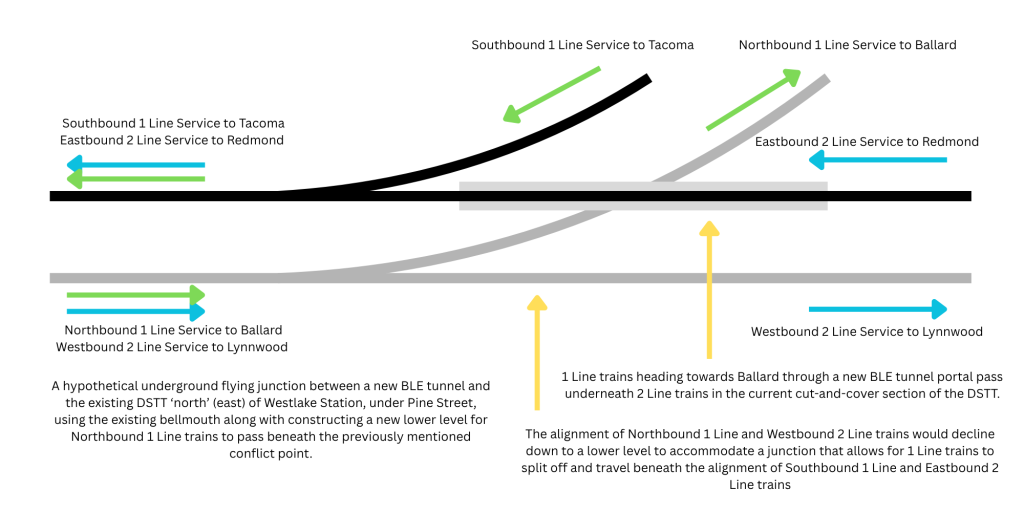
The following paragraphs entail modifications that could be made to this existing infrastructure under Pine Street that could accommodate a proper flying junction between BLE and the DSTT. However, the actual possibility of this being built is wholly contingent on whether Sound Transit can determine the feasibility of such a proposal, which would also need to include mitigations for extreme Link service disruptions during construction. As such, there are no guarantees that these proposals are actually feasible to construct.
The stretch of track between the end of the Westlake station box at 6th Avenue, and the bellmouth at 8th Avenue is roughly 750 feet long. Should it be possible for Sound Transit to engineer an alignment that allows for the set of tracks utilized by northbound 1 Line trains and westbound 2 Line trains to descend to a depth low enough accommodate a flying junction that can pass underneath the existing alignment, it could then be possible to connect Ballard Link to the DSTT.
However, many questions would still have to be answered, primarily: how would Sound Transit be able to construct a new junction box without disrupting existing Link service? It’s nice to draw a map with new lines, but potential service disruptions that could last not months, but years, is a likely non-starter. More importantly, by building a junction box in a location that is so much further east than the location of the DSTT2 Westlake station, Sound Transit would have to study a new Ballard Link tunnel alignment that accommodates a curve that can connect itself to the DSTT.
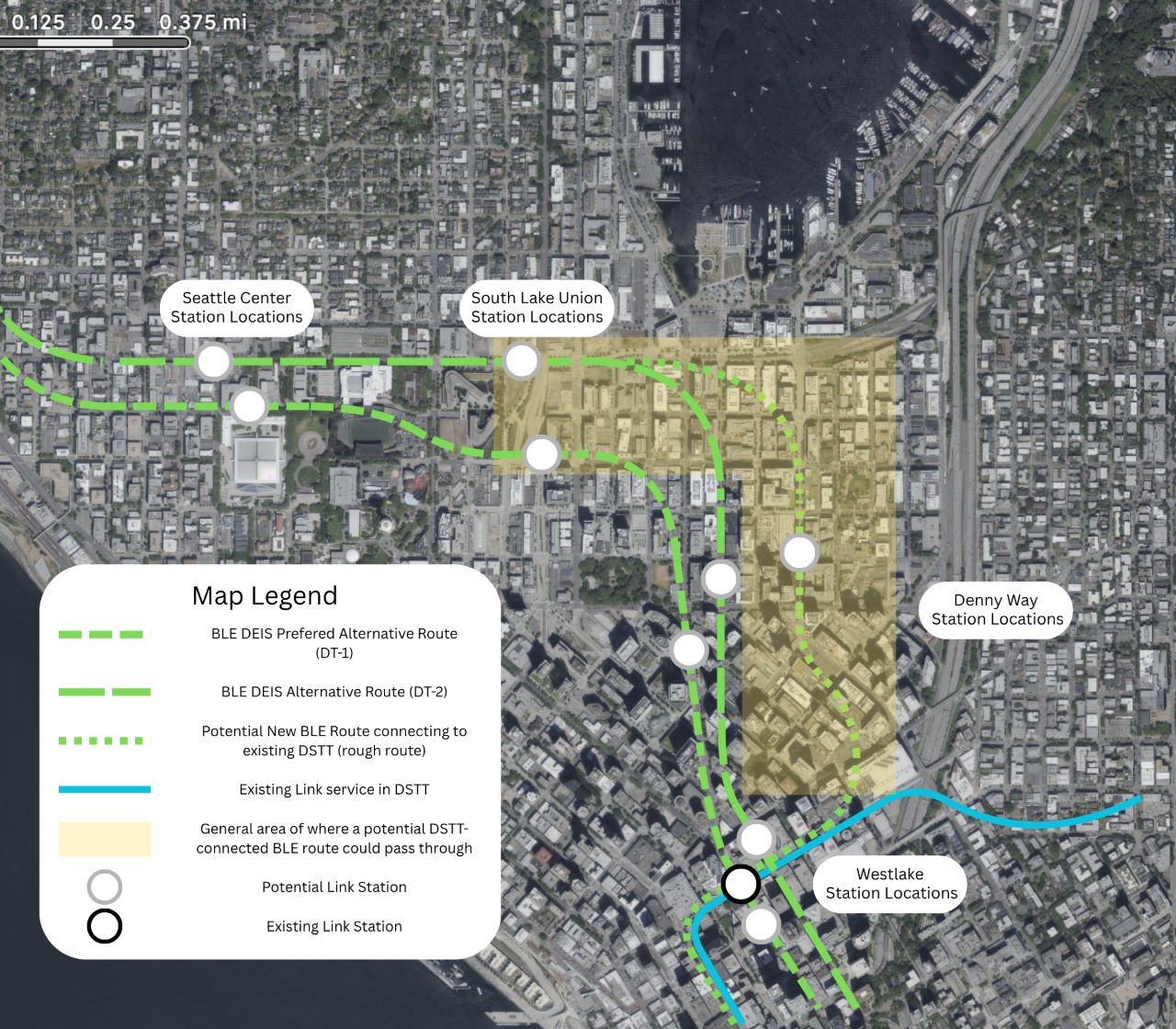
Ultimately, I do think there is merit in Sound Transit studying this suggestion, so that it can finally put to rest the people who are clamoring for this unrealistic dream. Ballard Link must be built with a proper DSTT2, and it can be built with cost optimization in mind. More ideas on that to come.

